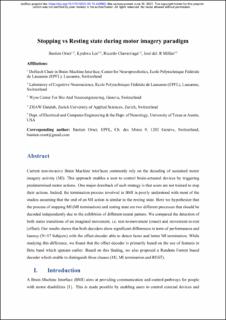Please use this identifier to cite or link to this item:
https://doi.org/10.21256/zhaw-23825Full metadata record
| DC Field | Value | Language |
|---|---|---|
| dc.contributor.author | Orset, Bastien | - |
| dc.contributor.author | Lee, Kyuhwa | - |
| dc.contributor.author | Chavarriaga, Ricardo | - |
| dc.contributor.author | Millán, José del. R | - |
| dc.date.accessioned | 2021-12-22T14:17:58Z | - |
| dc.date.available | 2021-12-22T14:17:58Z | - |
| dc.date.issued | 2021 | - |
| dc.identifier.uri | https://digitalcollection.zhaw.ch/handle/11475/23825 | - |
| dc.description.abstract | Current non-invasive Brain Machine interfaces commonly rely on the decoding of sustained motor imagery activity (MI). This approach enables a user to control brain-actuated devices by triggering predetermined motor actions. One major drawback of such strategy is that users are not trained to stop their actions. Indeed, the termination process involved in BMI is poorly understood with most of the studies assuming that the end of an MI action is similar to the resting state. Here we hypothesize that the process of stopping MI (MI termination) and resting state are two different processes that should be decoded independently due to the exhibition of different neural pattens. We compared the detection of both states transitions of an imagined movement, i.e. rest-to-movement (onset) and movement-to-rest (offset). Our results shows that both decoders show significant differences in term of performances and latency (N=17 Subjects) with the offset decoder able to detect faster and better MI termination. While studying this difference, we found that the offset decoder is primarily based on the use of features in Beta band which appears earlier. Based on this finding, we also proposed a Random Forest based decoder which enable to distinguish three classes (MI, MI termination and REST). | de_CH |
| dc.format.extent | 17 | de_CH |
| dc.language.iso | en | de_CH |
| dc.publisher | bioRxiv | de_CH |
| dc.rights | Licence according to publishing contract | de_CH |
| dc.subject.ddc | 006: Spezielle Computerverfahren | de_CH |
| dc.title | Stopping vs Resting state during motor imagery paradigm | de_CH |
| dc.type | Working Paper – Gutachten – Studie | de_CH |
| dcterms.type | Text | de_CH |
| zhaw.departement | School of Engineering | de_CH |
| zhaw.organisationalunit | Centre for Artificial Intelligence (CAI) | de_CH |
| dc.identifier.doi | 10.1101/2021.06.15.448360 | de_CH |
| dc.identifier.doi | 10.21256/zhaw-23825 | - |
| zhaw.funding.eu | No | de_CH |
| zhaw.originated.zhaw | Yes | de_CH |
| zhaw.webfeed | Machine Perception and Cognition | de_CH |
| zhaw.webfeed | Datalab | de_CH |
| zhaw.author.additional | No | de_CH |
| zhaw.display.portrait | Yes | de_CH |
| Appears in collections: | Publikationen School of Engineering | |
Files in This Item:
| File | Description | Size | Format | |
|---|---|---|---|---|
| 2021_Orset-etal_Stopping-Resting-state-motor-imagery.pdf | 1.36 MB | Adobe PDF |  View/Open |
Show simple item record
Orset, B., Lee, K., Chavarriaga, R., & Millán, J. del. R. (2021). Stopping vs Resting state during motor imagery paradigm. bioRxiv. https://doi.org/10.1101/2021.06.15.448360
Orset, B. et al. (2021) Stopping vs Resting state during motor imagery paradigm. bioRxiv. Available at: https://doi.org/10.1101/2021.06.15.448360.
B. Orset, K. Lee, R. Chavarriaga, and J. del. R. Millán, “Stopping vs Resting state during motor imagery paradigm,” bioRxiv, 2021. doi: 10.1101/2021.06.15.448360.
ORSET, Bastien, Kyuhwa LEE, Ricardo CHAVARRIAGA und José del. R MILLÁN, 2021. Stopping vs Resting state during motor imagery paradigm. bioRxiv
Orset, Bastien, Kyuhwa Lee, Ricardo Chavarriaga, and José del. R Millán. 2021. “Stopping Vs Resting State during Motor Imagery Paradigm.” bioRxiv. https://doi.org/10.1101/2021.06.15.448360.
Orset, Bastien, et al. Stopping Vs Resting State during Motor Imagery Paradigm. bioRxiv, 2021, https://doi.org/10.1101/2021.06.15.448360.
Items in DSpace are protected by copyright, with all rights reserved, unless otherwise indicated.